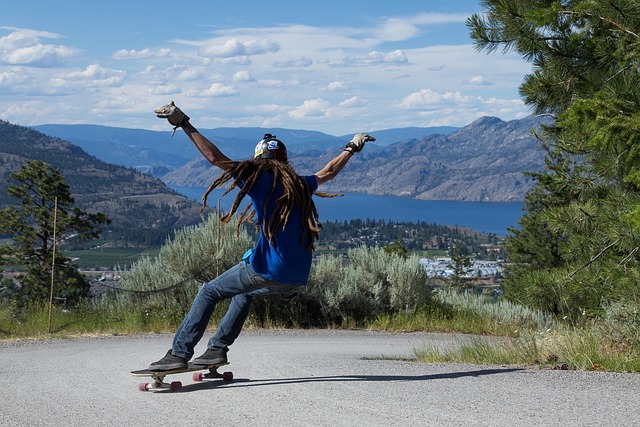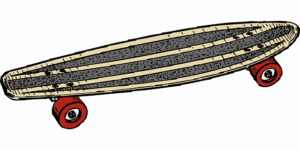Choosing the right longboard (90-100 cm, flexible, with suitable trucks and wheels) and mastering basic techniques (pushing, turning, ollies) is crucial for beginners. Set up your board strategically for stability and control. Practice cruising on different terrains to adapt skills. Master turns and maneuvers gradually. Upgrade accessories for comfort and safety. Build confidence through practice in quiet areas before advancing to busier ones.
Looking to embark on a smooth cruising experience with your longboard? This comprehensive guide is tailored for both new and experienced riders. From choosing the right longboard for your needs, understanding basic riding techniques, to setting up your board for optimal performance, we’ve got you covered. Learn tips for maintaining control, navigating different terrain types, incorporating turns safely, and enhancing your ride with accessories. Whether you’re a beginner or advancing your skills, these insights will transform your longboarding journey.
Choosing the Right Longboard for Your Needs

When it comes to choosing a longboard, selecting one tailored to your needs is paramount. For beginners, a board that offers stability and ease of control is essential. Look for longboards with wider decks, as they provide better balance and make learning tricks and maneuvers less daunting. The ideal deck shape should be versatile, allowing you to glide smoothly on both flat ground and gentle slopes.
Consider the flex of the board as well; a slightly flexible longboard absorbs vibrations, making your cruising experience more comfortable. Additionally, beginners will benefit from a longer board, typically between 90-100 cm, which offers more surface area for stability. Choose a deck with good grip tape to prevent slipping and ensure you have the right trucks and wheels for a smooth ride according to your preferred terrain.
Understanding Basic Riding Techniques

For those new to longboarding, understanding fundamental riding techniques is key to enjoying a smooth cruising experience. Start by mastering the art of pushing—this involves using your legs and feet to propel yourself forward while keeping a steady balance on the board. Practice different push styles like the traditional toe-side and heel-side pushes to build versatility and control.
Next, learn how to turn smoothly. Begin with basic carving turns, where you shift your weight to initiate a gentle curve. As you gain confidence, explore more advanced maneuvers such as tight turns, cutbacks, and even ollies for added enjoyment and control while cruising on your longboard for beginners.
Setting Up Your Board for Optimal Performance

When setting up your longboard for beginners, ensuring optimal performance starts with a strategic board setup. The first step is selecting the right deck that suits your style and skill level. For newcomers, a drop-through or top-mount design can offer enhanced stability and control, making learning to cruise and turn easier. Deck shape also plays a significant role; choose one with slightly longer wheels for better speed and smoothness on different terrains.
Next, focus on wheel placement. Mounting wheels closer to the truck bases can improve agility and make tight turns more manageable. Consider your riding style and whether you prefer a more responsive or stable setup. Remember, the right board setup will not only enhance your cruising experience but also contribute to better control and confidence as you progress from beginner to advanced levels.
Tips for Maintaining Smooth Control While Cruising

Maintaining smooth control while cruising on a longboard, especially as a beginner, is an art that combines balance, technique, and practice. The key to a seamless ride lies in understanding how to distribute your weight evenly across the board. Keep your center of gravity low by bending your knees slightly, which not only enhances stability but also improves your ability to navigate turns smoothly.
For beginners, focusing on a steady, relaxed pace is crucial. Avoid sudden speeds as they can disrupt your balance. Instead, take your time and let the flow of the ride guide you. Practice makes perfect; the more you cruise, the better you’ll become at anticipating and adjusting to road conditions, ensuring a smooth and enjoyable journey every time.
Navigating Different Terrain Types

Cruising on a longboard for beginners can be an exciting journey, but navigating different terrain types is key to a smooth experience. From smooth, paved roads to rougher, cobblestone paths, each surface presents unique challenges and requires adjustments in technique. Beginners should start with flatter areas to get a feel for balancing and carving turns before progressing to more varied landscapes.
Understanding how your longboard behaves on different terrains is essential. Softer surfaces allow for easier turning and more playful maneuvering, while harder, uneven grounds demand better control and stability. Practicing on various terrains helps beginners develop the skills needed to adapt their riding style accordingly, ensuring a safer and more enjoyable cruising experience.
Incorporating Turns and Maneuvers Safely

When cruising on a longboard for beginners, learning to navigate turns and maneuvers safely is a crucial step. It’s all about building confidence and precision. Start with basic turns, focusing on maintaining control and stability as you lean into each curve. Remember, a smooth, controlled turn is safer than a sudden one. Practice in an open, flat area to get a feel for balancing your board and adjusting your stance accordingly.
As you progress, incorporate more advanced maneuvers like carves and cutbacks. Carving involves leaning the board from side to side while cruising, creating a flowing motion. Cutbacks, on the other hand, are sharper turns where you quickly shift your weight to initiate the turn. Always be mindful of your surroundings and ride with respect for others, especially in busy areas. Consistent practice will ensure these maneuvers become second nature, making your cruising experience smoother and more enjoyable.
Enhancing Your Riding Experience with Accessories

Upgrading your longboard can transform your cruising experience, especially if you’re new to the world of longboarding. Accessories play a significant role in enhancing both comfort and performance. For beginners on a longboard for beginners, a good quality seat and handlebar grip are essential; they ensure you stay comfortable during longer rides and provide better control, making your journey smoother.
Additionally, consider adding a backpack or belt to carry essentials like water bottles, a repair kit, and protective gear. These accessories not only make your ride more enjoyable but also prepare you for any unexpected challenges on the road. With these simple additions, you can elevate your longboarding experience from good to great.
Advanced Techniques for Confidence on the Longboard

For those new to the world of longboarding, building confidence is key to enjoying a smooth cruising experience. Start by mastering basic techniques like carving and turning, focusing on maintaining control and balance. Practice makes perfect; find a quiet, open space to hone your skills until you feel comfortable navigating turns with ease.
As your confidence grows, incorporate advanced maneuvers such as pump turns and cutbacks. These techniques allow for more dynamic cruising, helping you maintain speed while carving through turns. Remember, always stay aware of your surroundings, especially in busier areas, ensuring a safe and enjoyable longboard journey.
